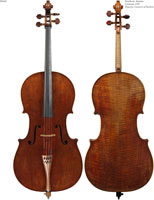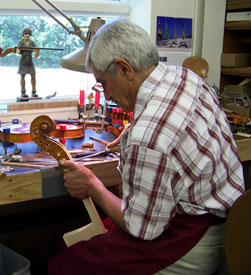In today's post, I ask the big question: is the string community just fooling itself by paying so much for Stradivarius cellos and violins? If you'd like to contribute to our blog -- as a Suzuki parent, player, or teacher -- email me at joec@sharmusic.com.  Although I'm not a musician -- I'm a writer -- I've found myself fascinated by the recent discussion of Bernard Greenhouse's Countess of Stainlein Stradivarius cello. After Greenhouse's death, his daughter and son-in-law Elena and Nicholas Delbanco sold Greenhouse's cello for more than 6 million dollars. That's a lot of money, and though money isn't everything, it is how we mark the value of objects. (Even John & Paul give us contradictory wisdom on this one: "Can't Buy Me Love" and "You Never Give Me Your Money" don't exactly send the same message.)
Although I'm not a musician -- I'm a writer -- I've found myself fascinated by the recent discussion of Bernard Greenhouse's Countess of Stainlein Stradivarius cello. After Greenhouse's death, his daughter and son-in-law Elena and Nicholas Delbanco sold Greenhouse's cello for more than 6 million dollars. That's a lot of money, and though money isn't everything, it is how we mark the value of objects. (Even John & Paul give us contradictory wisdom on this one: "Can't Buy Me Love" and "You Never Give Me Your Money" don't exactly send the same message.)
I can't but think, too, that maybe there's a bigger question behind my fascination with Greenhouse's cello: as artists and musicians, what is our relationship with our instruments? I guess I'm not just talking about consumer objects but more so the instruments through which we make art (though there is certainly overlap).
I'm attached to my writing desk and my computer. I'm attached to my fancy leather-bound journal and a certain type of pen. I know writers who are even more particular. A dear friend and mentor from graduate school once admitted that as a young writer she absolutely needed two tables (one for her typewriter and one for the books necessary to her project), a pot of coffee, and a pack of cigarettes. And so I wonder about the things that I think I need. Do I need to write at the same desk and with the same pen? Do they affect my writing?
I'm not sure this line of thinking carries over as neatly as I would like into the world of high-end instruments. A quality pen is much less essential to writing than a quality violin is to making music. That said, the comparison to writing does bring up questions for me and everyone else salivating over Greenhouse's Stradivarius cello, namely whether the Stradivarius violin simply produces better sound than other violins or if we've falsely come to believe that.  There's more to complicate the question. An experiment by the National Academy of Sciences found that 8 of 21 players, in a blind test, preferred to take home newer instruments rather than old ones. To add insult to injury, a Stradivarius violin came in last place: it was the least preferred instrument. Of course, there were a few problems with the experiment -- a limited number of test violins were used and the experiment was carried out in a hotel room with predictably poor acoustics -- but the results are still troubling. The Stradivarius came in last place? Seriously?
There's more to complicate the question. An experiment by the National Academy of Sciences found that 8 of 21 players, in a blind test, preferred to take home newer instruments rather than old ones. To add insult to injury, a Stradivarius violin came in last place: it was the least preferred instrument. Of course, there were a few problems with the experiment -- a limited number of test violins were used and the experiment was carried out in a hotel room with predictably poor acoustics -- but the results are still troubling. The Stradivarius came in last place? Seriously?
Instruments made by the famous Italian craftsman Antonio Stradivari are said to be capable of subtler expression, and Greenhouse, of course, agrees. In “The Countess of Stanlein Restored: A History of the Countess of Stanlein ex-Paganini Stradivarius Cello of 1707," written by his son-in-law Nicholas Delbanco, Greenhouse says:
The quality of sound is something that one wears, that adorns an individual as though it were a beautiful piece of apparel. The ear can be deceiving sometimes; sometimes I’ll pick up one of the lovely modern celli in the morning and be very happy with it, but in the afternoon I’ll ask what could possibly have pleased me.
And here's how Daniel J. Watkin in his NY Times article "Selling a 300-Year-Old Cello" describes Greenhouse's playing:
In a Beaux Arts recording of Schubert’s Trio in E flat, the elegiac opening measures of the Andante con Moto movement convey everything beautiful about his playing. The vibrato is light and warm; the notes taper elegantly. The drop in the 15th measure to a low G sounds like a cat jumping onto a carpet.
I love that Greenhouse discards modern celli like unsatisfactory lovers. But what I find most interesting is how individualized both Greenhouse and Watkin approach playing. Greenhouse equates quality of sound to one's clothing, something that's worn, and Watkin's idiosyncratic metaphor compares Greenhouse's drop in the 15th measure to "a cat jumping onto a carpet." These metaphors suggest that the quality of one's playing is like style: if it's done right, no one else can pull it off.
Greenhouse and Watkin would surely scoff at any objective test of the quality of an instrument's sound. I agree. It's a little absurd. The player and the instrument are in a relationship and the result is their style of sound. If the player is a master player, the sound will not be better or worse in any scientific sense, although aficionados will of course disagree on the quality of the style.
Now that I think about it, though, the upshot of all this is that when a master player passes on his instrument, we lose a style, a voice. Meaning, no one else will be able to play the Countess of Stanlein cello quite like Bernard Greenhouse did.


